In addition to its numerous beaches, visitors to Nerja will discover various places of interest and things to do, from visiting churches to country walks to enjoying the large array of tapas bars and restaurants in the town.
Acueducto del Águila
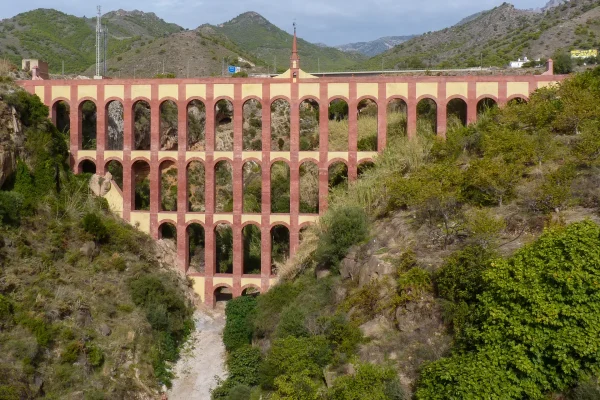
The XIX century Eagle Aqueduct – Acueducto del Águila is located on the Barranco de la Coladilla about 3km outside Nerja on the N-340 coastal road leading to Maro.
It was built under the direction of local master builder Francisco Cantarero and consists of four storeys of superimposed brick arcades with 38 arches. The facade was decorated with a gallery of blind, pointed horseshoe arches in the Mudecar style.
The aqueduct also features entrance templets on the top storey and a central templet with an inscription reading ‘Pura y Limpia Concepción’ (Pure and Clean Conception).
It was restored during the period 2009 to 2011 after having suffered damage….during the Spanish Civil War. It is still in use today.
Balcón de Europa

The Balcón de Europa – Balcony of Europe – is situated on a rocky promontory and was formerly a fortress designed to keep out British pirates and privateers. The rocks you see when looking over the end are the remains of the old fortress.
The area is the focal point of Nerja and is considered to be the ‘centre of town’. The name ‘Balcón de Europe’ itself is generally believed to have been coined by King Alfonso XII during his visit to Nerja in 1885.
The Promenade – Paseo Balcón de Europa – is pedestrianised, as are the adjoining streets (calle Puerta del Mar, calle Pintada, calle Cristo and calle Carabeo) and it is lined with cafés, restaurants and ice cream parlours. During the busy summer months it is a hive of activity until late at night with street musicians, artists and other activities taking place.
Two old cannons adorn the viewpoint, these having been found buried within the municipality.
La Ermita de Nuestra Señora de las Angustias
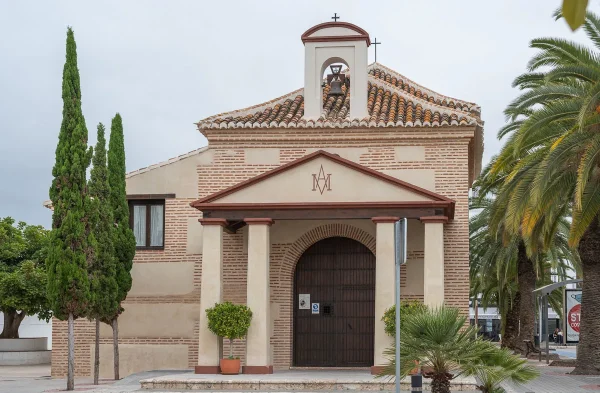
La Ermita de Nuestra Señora de las Angustias in Plaza de la Ermita, Nerja, was completed in 1720 and contains frescoes of the four evangelists dating back to the 17th and 18th centuries. The interior is quite ornate.
Nuestra Señora de las Angustias – Our Lady of Sorrows – is the patron saint of Nerja and features in many of the celebrations in the town.
The Ermita plays host to several small concerts (classical, choral, religious) throughout the year so keep an eye out for posters promoting such events.
Rapto de Europa

Spain became integrated into the EEC in 1986 and, in commemoration of this historical event, the Rapto de Europa sculpture was erected at the western entrance to Nerja next to the N-340 coastal road.
The sculpture is the work of Aurelio Teno, and other examples of his work can be found in Nerja, including an equestrian sculpture located on calle Málaga and another in the iglesia El Salvador on the Balcón de Europa.
Aurelio Teno was born in 1927 in Las Minas del Soldado in Villanueva del Duque and worked as an apprentice to the sculptor Amadeo Ruiz Olmos and later in a silversmiths in the city. In 1939 he joined the School of Arts and Crafts in Córdoba to study drawing and painting and remained there until 1943. In 1950 he moved to Madrid and worked as a goldsmith before moving to Paris to further his art studies.
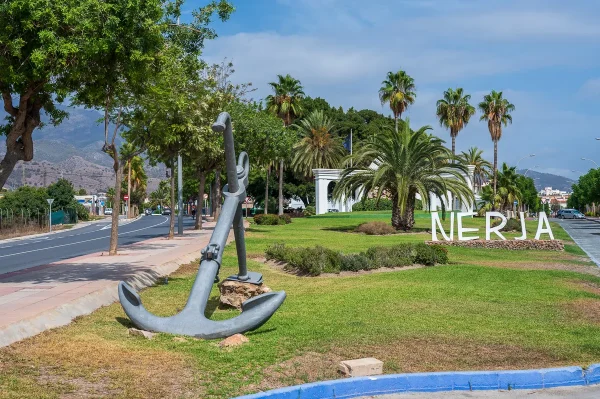

Aurelio Teno returned to Madrid in 1965 to continue what had been a successful career. In 1976 he achieved international acclaim for a monumental sculpture of Don Quijote which is displayed in front of the Kennedy Centre in Washington D.C. He died at his home in El Pedrique, Córdoba, in February 2013.
Mirador del Bendito

The Mirador del Bendito is a viewpoint looking out over Carabeillo beach, with seating and two large pergolas for shade and decoration.
The Mirador lies at the end of calle Hernán de Carabeo – also known just as calle Carabeo – and there are several cafes, bars and restaurants in the area.
Iglesia El Salvador

The 17th century Church of El Salvador – Iglesia El Salvador – is located on the edge of the Balcón de Europa and is close to what was once the old Guards Tower.
The original church was erected in 1505, although the existing structure was not actually built until much later, in 1697, and it was then further extended during the period 1776 – 1792. It is constructed as a three naved cross, the central area covered with a wooden framework of paired braces, the sides featuring vaulted edges at the ends and half barrel vaults with windows in the remainder.
On the front of the church are two quite large and typical ceramic tile plaques, one detailing the history of the church, the other a colourful religious scene. The exterior features a four-sided bell tower, originally built in 1724 but later reformed. An ornate Rosas clock also adorns the bell tower.
The interior is noted for its 18th century frescoes decorating the Evangeline nave and the contemporary mural of the annunciation by the painter Francisco Hernandez.
Fabrica San José

The Fábrica San José on calle Antonio Ferrandis ‘Chanquete’ was built by the Martinez Manescau brothers and Gabriel Rodriguez Navas back in 1870.
In 1873 the property came into the hands of the Larios family and they proceeded to turn the building into one of the most important sugar factories in Nerja.
The factory continued to be fully operational until 1968. The building was later restored and turned into a state secondary school, with efforts made to retain some of its original characteristics. The tall chimney is one of the original features still remaining intact.
Puente Viejo

The Puente Viejo (Old Bridge) can be found at the western end of town. It was built in 1860 and is the main access to Nerja from the old N-340 coastal road.
It has been destroyed by floods on two separate occasions.
The road surface of the bridge was formally cobbles, but these were removed in 2017 following a local referendum and the surface is now tarmac.
Parque Verano Azul

The Parque Verano Azul, named after the famous Spanish TV series from the 1980’s which was set in Nerja, contains a replica of the fishing boat ‘La Dorada’ from that series.
The park also has petanca courts, a football pitch, a large children’s play area and wide avenues for taking a gentle stroll. All the avenues are named after characters from the TV series and are marked with ornate ceramic name plaques.
Dotted along the path are various pieces of exercise apparatus and even a table tennis table, all free to use.
The park borders the rio Chillar and the river walkway. Very picturesque when all the plants and trees are in bloom.


Nerja Caves

The magnificent Nerja Caves – Cuevas de Nerja – are a series of huge caverns stretching for almost five kilometres and home to the world’s largest stalagmite, a 32 metre high column measuring 13 metres by 7 metres at its base.
More Info: Nerja Caves
Detunda-Nerja Caves Botanical Garden

If you like plants then you can always have a wander round the Detunda-Nerja Caves Botanical Garden – jardín botánico Detunda-Cueva de Nerja, which covers an area of 26,000 square metres and contains around 200 species of plants found in the mountains of Málaga and Granada provinces.
The gardens are located in the grounds of the Nerja Caves.
More Info: Nerja Botanical Garden
Fábrica San Miguel
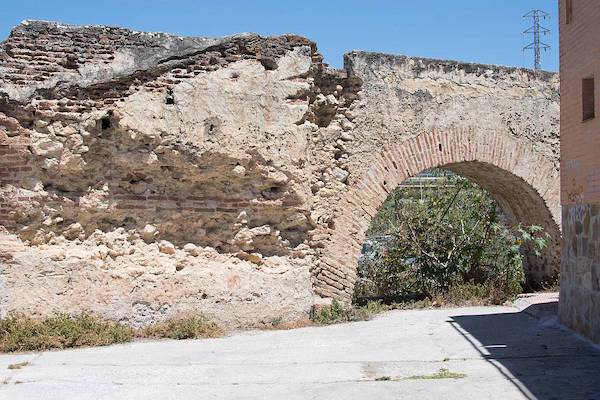
The Fábrica San Miguel is listed as a Site of Interest in Nerja, although very little remains of the old sugar mill apart from an archway and a few bits of walls. It is located behind an apartment block on calle Puente Viejo – the road from the Carrefour roundabout down to the rio Chillar riverbed.
San Joaquín Sugar Mill

The former San Joaquín Sugar Mill on the N-340 between Nerja and Maro is one derelict site which, for me, falls into the ‘character’ category. The ruins look a bit ‘eerie’ in some ways, particularly in half-light and also because they are so isolated.
The mill was built in 1884 by Francisco Cantarero and owned by the Marquis de Tous. It closed down in 1911 and then, in 1930, was acquired by the Larios sugar company and reopened. A distillery was also part of the complex. It closed for the final time in the early 1970’s.
Hike the rio Chillar

Walking along the rio Chillar – the upper reaches – is very popular, particularly in the summer, and you will see a magnificent gorge (where you actually have to walk in the river itself), a couple of waterfalls and small pools where you can take a dip to cool off.
For a shorter walk, or even bike ride/jog/run or scoot, the first 1.4 km from El Playazo beach to Puente Viejo is a paved walkway (on both sides) with cycle path and seating at regular intervals.
More Info: Rio Chillar


Markets

Why not pop up to the regular Tuesday Market or the Sunday Car Boot Sale and snag the odd bargain or two?
You will find everything from local fruit and veg to handbags, clothes and home decor.
Wander up to Almijara II or catch the Blue Bus which will take you to the market in no time at all. The bus starts out from the stop near the Hotel RIU Monica in avenida Mediterraneo.
Various other artisan markets are held periodically throughout the year, many in Plaza de España.
Easy Day Trips from Nerja
Within a short distance of Nerja – max 40 minutes by bus – are several towns worth visiting:
Torrox Costa (beach resort with excellent promenade) and Torrox Pueblo (traditional white-washed hillside town). 10 minutes by bus.
Frigiliana (hillside Moorish town considered one of the most picturesque in Andalucia). 15 minutes by bus along a very scenic route.
La Herradura (beach resort in Granada province). Nice beach but little else. 15 minutes by bus (very scenic route).
Almuñécar (beach resort in Granada province) is well worth a visit with a lot to see and do: castle, aquarium, excellent beaches, promenade, bird park and cactus garden, Majuelo Botanical Garden, saltwater water park (Aqua Tropic) as well as an old town centre with narrow streets, plazas, shopping and great places to eat. There is also a very good weekly market each Friday. 30 minutes by bus along a very scenic route.
Torre del Mar is a popular resort (and working town) with excellent beaches, superb promenade (with very good eateries), great shopping, water park (Aqua Velis) and more. 30 to 40 minutes by bus.
Nerja Sculptures and Statues
There are quite a few statues and sculptures dotted around Nerja. Starting on the Balcón de Europa, generally considered to be the centre of town, we have three items of interest, these being:
Sculpture of King Alfonso XII

King Alfonso XII (1857 – 1885) is widely credited as being responsible for naming the Balcón de Europa and turning it into an emblematic site. The king visited Nerja in 1885 to view for himself the damage caused by the devastating earthquake which took place on December 25th 1884, and it is during this visit he is alleged to have stood by the cliffs and said, ‘This is the Balcony of Europe’.
True or not – there are accounts that it was already being described as ‘the Balcony of Europe’ long before the royal visit – it is an interesting tale.
The king was removed from the Balcón de Europa in 2020 while new railings were being installed. The sculptor, Francisco Martín, took the opportunity to clean and retouch the emblematic statue. In addition, as the new railings are about six inches taller than the old ones, a few ‘adjustments’ were necessary in order for his to return to his old spot.
The statue of the diminutive monarch is certainly one of the most, if not the most, photographed object in Nerja. Selfies with the king are seen as almost a ‘must’ when visiting the town and he can often be seen sporting sunglasses, hats, scarves and, these days, a face mask.
Caves Discoverers

In April 2010, a sculpture commemorating the discovery of the Nerja Caves was added to the Balcón de Europa, the work of Francisco Martín. This is the second sculpture on the Balcón de Europa by this artist, the other one being the highly popular statue of King Alfonso XII.
On January 12th 1959, five local lads from the village of Maro decided to go hunting for bats and headed for a pothole known locally as ‘La Mina’ where they spent the night watching a great number of these creatures exiting through the hole in the rocks.
The boys returned the next day, taking with them some tools to dislodge a couple of stalagtites in the entrance. Once inside, they were able to descend to a huge cavern where they discovered a number of skeletons next to some ceramic pottery.
Excited by their find, they went back to tell their family, friends and teachers but it wasn’t until the cave was visited by a medical expert and a photographer that the true extent of their discovery became apparent.
The young lads involved were:
- Francisco Navas Montesinos
- Manuel Muñoz Zorrilla
- Miguel Muñoz Zorrilla
- José Luis Barbero de Miguel
- José Torres Cárdenas
Their names appear on the base of the sculpture.
Ship’s Wheel

This ship’s wheel was moved to the Balcón de Europa in 2017 after spending many, many years outside the bar Kronox opposite the iglesia El Salvador.
Heading down to Calahonda beach from the Balcón de Europa we have the statue paying homage to the old sea dog ‘Chanquete’ from the TV series ‘Verano Azul’.
Chanquete

Yet another nod to the 1980’s TV series ‘Verano Azul’, widely credited as having put Nerja ‘on the map’, a statue formerly at Calahonda beach but relocated to the El Salon beach ‘mirador’ in September 2022.
This statue, another by the sculptor Francisco Martín, pays homage to the character ‘Chanquete’ who was played by the actor Antonio Ferrandis. The sculptor’s other works include the statue of King Alfonso and the homage to the discoverers of the Nerja Caves, both of these pieces being situated on the Balcón de Europa.
Calle Málaga

At the top of calle Málaga, Nerja, is this statue, one of several in town by the renowned Córdoban sculptor Aurelio Teno.
Aurelio Teno Teno was born on September 7th 1927 in Mina de Soldado, Córdoba. Between 1936 and 1943 he lived in Córdoba, training as an artist in several disciplines. He began as an apprentice with the sculptor Amadeo Ruiz Olmos, then moved to a workshop specialising in silver before studying painting and drawing at the School of Arts and Crafts in Córdoba.
In 1950 he moved to Madrid to work as a goldsmith and thereafter spent ten years in Paris, continuing his studies of the fine arts and during which time he exhibited his paintings in a number of well-known galleries, such as the Palais de Beaux Arts.

In 1960, Aurelio Teno returned to Madrid, although he set up his studio in Molino del Cubo in Ávila. He began a series of international exhibitions in St Louis, Copenhagen, Paris, New York and Rabat and in 1976 won an international competition to design a sculpture of Don Quixote to be placed in front of the Kennedy Centre in Washington, beating off competition from no lesser figures than Salvador Dali and José de Creeft.
The iglesia El Salvador on the Balcón de Europa in Nerja also contains a statue of Christ by Aurelio Teno, this one fashioned in bronze.
The sculptor finally moved his workshop, with a museum dedicated to his work, to an old monastery in Pedrique in the municipality of Pozoblanco.
Aurelio Teno Teno died in Córdoba on February 1st 2013 at the age of 84 years.
Calle Pintada
In calle Pintada, at the junction with calle La Cruz, is this piece of rock from the famous Nerja Caves. The ‘sculpture’ was erected in 2003.
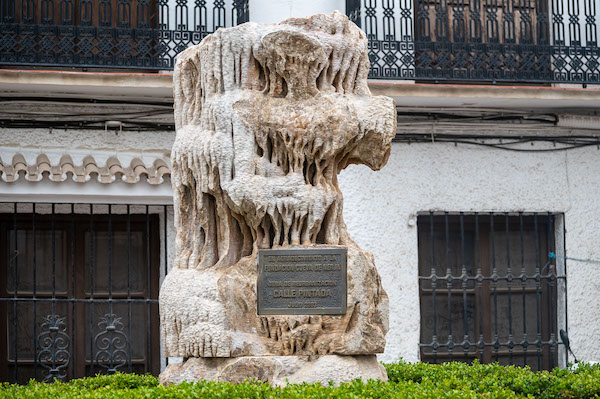

Fuente de Europa
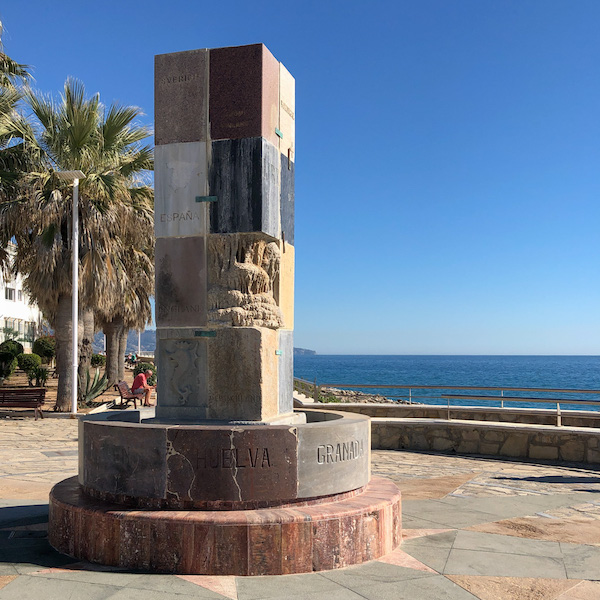
At the bottom of Plaza Fabrica de los Cangrejos, in the centre of the viewpoint, is the Fuente de Europa, a fountain/monument made from stones donated by the various EU member states.
The fountain started out in the Parque Verano Azul but, not only did it become a bit obscured as the park was expanded or remodelled, late night drinkers were using it as a urinal and so the decision was eventually taken to move it to its current location near Torrecilla beach.
Plaza Cronista Pepe Pascual

Plaza Cronista Pepe Pascual, named after Pepe Pascual, Official Chronicler of Nerja and the Nerja Caves, is situated opposite the Parque Verano Azul and contains a small statue sculpted by Francisco Martín.
On the occasion of his 71st birthday on June 3rd 2010, Pepe Pascual was officially given the honour of being named Hijo Predilecto – Favourite Son – and, in addition, the newly built square above the car park was given his name.
Pepe Pascual, full name José Adolfo Pascual Navas, passed away on May 4th 2012 at the age of 72 years.
Rapto de Europa

Nerja is home to several sculptures by the renowned Córdoban artist Aurelio Teno, the most famous of these being the Rapto de Europa, a monument commemorating the entry of Spain into the European Union in 1986.
El Encuentro

A sculpture entitled ‘El Encuentro‘ adorns the roundabout at the western entrance to Nerja. It dates from 2005 and is the work of sculptor Robert Harding, although the official municipal ‘Point of Interest’ sign board unfortunately calls him Robert Halding. Twice. Poor guy.
The piece symbolises Nerja as a ‘meeting’ place and a nexus where different cultures, villages and even continents can join together.
Homage to ‘Ayo’

A (2022) sculpture in homage to Francisco Ortega Olalla, otherwise known as ‘Ayo‘, in recognition of his contribution to the development of athletics in the municipality.
It is located by the skate park near the sports stadium.